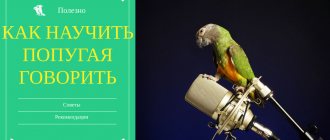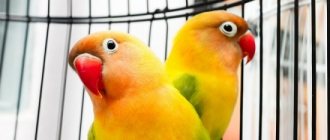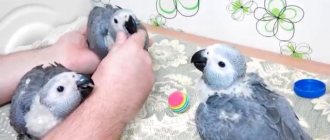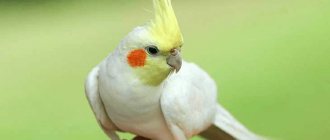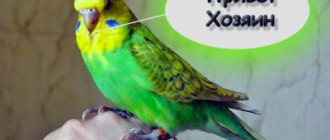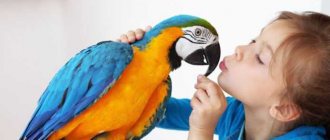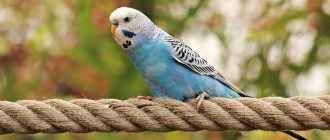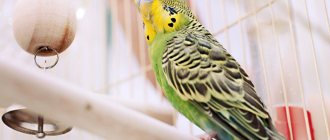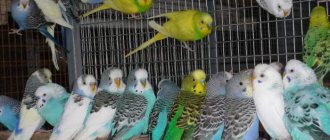A small defenseless creature in feathers, once settled in a house, quickly becomes the center of attention, the main toy of adults and children. Initially green, as a result of repeated crossing and mixing, domestic wavy feathers wear feathers of almost the entire spectrum. Thanks to their natural tendency to repeat, smart birds learn human speech and have funny conversations with their owners and their friends. The vocabulary of a feathered friend can contain more than a hundred words, many of which he very opportunely inserts into conversation.
Parrots are predisposed to repeating sounds they hear; all that remains is to give them the opportunity to hear what we then want to hear from them. You can achieve results by learning how to teach a budgie to speak. There are many practical tips and scientific statements on this matter. Let's start in order.
Is it possible to quickly train a parrot to talk?
It is a well-known fact that parrots are capable of reproducing human speech. However, birds do not “talk” on their own. In order for your pet to say at least one word, training is necessary. This process is lengthy; it is not easy to teach a bird to pronounce words. Depending on the bird’s abilities and its species, training can take from 3 months to a year, subject to daily regular training. Note that there are birds that are not capable of reproducing words. Let's look at the most popular types of parrots for their learning ability:
- Wavy. Is it possible to teach a budgie to talk? This species is considered one of the most chatty. They begin to “speak” earlier than others, but it is still not possible to quickly teach them human words. The vocabulary of these birds can reach several hundred words, and their pronunciation can be called perfect. There are cases where budgies reproduced poetry. A trusting relationship with your pet will help speed up the learning process. However, for the bird to “speak” it will take not a single day or even a month.
- Corella. This type of parrot does not have special learning abilities. It is quite possible to teach a cockatiel to talk, but the process is more difficult and lengthy than in the case of budgies. In addition, the vocabulary of these birds is less rich and the pronunciation of words is not as clear. A cockatiel can learn no more than 10 words. Only young individuals can be trained. Adult birds are not capable of reproducing words.
If the pet is young, then training should begin with hand training. After the bird ceases to be afraid of people, they begin directly to speech exercises and activities. Corella is a smart pet and can become a “teacher” himself. A “talking” parrot of this species can teach speech to other birds and small children.
- Lovebird. These pets are among the most taciturn when it comes to human speech. At the same time, individual individuals can be trained. A lovebird can learn the pronunciation of 5 words. The learning process will be long; parrots of this species do not learn words quickly. In addition, only young individuals can learn to “speak.” If the lovebird “speaks,” then he will pronounce the words clearly.
- Rosella. This species, like the previous ones, does not differ in speech abilities. Rosella can learn a few words. The bird's vocabulary is limited to the name of the owner and some other word that is directly related to the bird itself. Learning to speak in rosellas is a long process and not always successful. If you expect that your pet will be able to learn a few phrases, then don’t get your hopes up.
- Cockatoo. This bright giant has not only an exotic appearance, but also high learning abilities. The cockatoo is capable of reproducing human speech - words and individual phrases. This feature of the bird allowed him to become one of the most popular participants in circus shows. However, it takes a lot of time to train a pet. It is not possible to quickly teach a cockatoo to speak.
- Jaco. The smartest parrots are grays. Their unprepossessing appearance is more than compensated by the bird's ability to imitate the human voice. According to breeders, the Gray Gray is the most chatty bird among parrots. His vocabulary contains at least a hundred words and short phrases. Thanks to its inquisitive mind, the Gray learns quickly, remembers words for a long time and is able to use them exactly in accordance with the situation.
Can a budgie learn to say words in 1 day of training?
Some people are interested in a slightly different question: “How can you teach a budgie to talk in 5 minutes?” In general, if we talk about talking parrots, then the most talkative ones are not budgies. Without any problems, you can teach a Macaw or a Gray to speak at home. But when teaching wavy animals to speak, you need to spend a lot of effort. Of course, everyone wants to quickly teach their pet bird to speak. But in fact, in order for your budgie to say its first word, you will have to give it a lot of training.
If you regularly train your pet, then after about three to five months , he will begin to say something. Train yourself to do these exercises consistently. At the same time, of course, all parrots are different, each has its own abilities. Some may need more time, others less. But before two to three months of training, don’t even expect that the bird will utter its first word. However, when the ice breaks, your talking budgie will begin to make noticeable progress, teaching him further will be more enjoyable and the learning process will go faster. That is, you definitely won’t be able to teach a bird to speak well quickly, in 5 minutes or in one day.
If your parrot listens to the word you pronounce for him and tries to catch it, then this is the result for the first training. Sometimes the parrot's beak will open and he will try to say your word in response. But this will not be the word that you are learning with him, but just some kind of sound. If your feathered friend tries to answer you something already in the first lesson, then that’s just great! Know that you have a very talented bird! This means that the further process of teaching a budgie to talk will not cause any great difficulties.
At the same time, keep in mind that you do not need to teach your budgie to speak immediately after you bought it and brought it home. It is necessary that after the purchase the bird adapts and gets used to you so that it can trust you. This usually takes one or two weeks . Only after this can lessons be taught.
Does a parrot's gender affect its ability to speak?
According to most bird trainers, it is believed that it is much easier to teach a boy the ability to pronounce words than a girl. This fact is confirmed by examples of a record vocabulary possessed by males. So the most sociable is the budgerigar Puck, who knew 1770 words. However, this does not mean that girls cannot “speak” at all. The exception is the female Australian parrot. To teach your budgie boy to talk, there are a few important things you should know.
Which parrot to choose for training?
Among all mockingbirds, the ability to speak is more pronounced in males than in females . Females can also be taught human speech, but they will be able to remember no more than 10-20 words. Therefore, those who decide to train a budgie are advised to choose a boy.
You need to buy a bird at the age of 35-50 days from birth. At this time, the parrots are already leaving the parental nest and feeding on their own. Many bird lovers who have been breeding and training budgerigars for a long time believe that the training result can be even better if the chick is taken a few days before leaving the nest. In this case, he will have to be fed independently from a spoon , which requires certain knowledge and experience.
Rules for teaching parrots to talk
- European manicure - technology for performing the procedure step by step
- Leg of lamb baked in the oven: recipes
- How long do they live with cirrhosis of the liver - the degree of the disease. Stages of liver cirrhosis and life expectancy
The process of teaching a parrot to speak is long and laborious. It requires patience from the person who has taken on the role of teacher. According to ornithologists, parrots perceive the speech of women and children better, so the owner of the pet is preferable as a teacher. One person should handle the bird. In addition, the following rules should be taken into account:
- Classes are conducted in complete silence, as parrots are naturally terribly curious. If the silence regime is not observed, the “student” will become distracted and will not remember the required combination of sounds. Particular attention should be paid to the TV. The sounds coming from it will not allow the bird to concentrate.
- Teaching words should be accompanied by corresponding action. When learning the word “hello”, you should enter the room, and “bye” is said if you leave the room.
- Classes should be scheduled at the same time. The duration of the lesson should be 15-20 minutes. In addition, once a week it is recommended to conduct a long strengthening lesson for 40-45 minutes.
- The first word to learn must have two syllables.
- To facilitate training, the use of a tape recorder or voice recorder is allowed. The recording periodically turns on and off, but during the lesson you must be close to the “student”.
- It is necessary to interest the pet and maintain its curiosity throughout the lesson. Signs such as head movements, wing twitching and blinking indicate interest on the part of the ward.
- You can't yell at the bird and punish it. If the student is not in the mood to study, you should give him a treat that will attract his attention.
- One of the rules of learning is persistence. Even if the “student” does not want to study, it is necessary to attract his attention.
- Young parrots should be taught from the age of 2 months.
Six tips to follow when learning to speak
When we teach our birds to talk, to achieve a good result it is necessary to take into account one feature of talking budgies. The training words that they begin to pronounce as a result of training are perceived by them as new songs. Budgerigars speak “their own language” consciously. They cannot understand our language consciously. Therefore, the sounds they make are just an imitation of our words. Thus, the main task of a person who wants to teach his budgie to speak should be the correct organization of training. If you train correctly, your winged pet will be able to master “our song.”
There are some rules that will help teach a male or female budgie to speak using human speech. Let's look at them.
- The first thing you need to do is get to know your parrot well. It is necessary to communicate with the bird, take care of it, so that the pet trusts you emotionally and feels safe. Otherwise, the parrot will not listen to what you say to it, or it will become stressed. Of course, there can be no talk of any training in such a state. Tame your pet correctly! That is, first it is necessary for him to adapt to the new place of residence and you need to become a good friend for the bird being trained . Only after this can the budgerigar be tamed to speak.
- The next step is to choose the first word . Usually, the owners choose the parrot's name as the first word to learn. To begin, say the whole name (or some other chosen word). If you notice that a whole budgerigar is not able to learn a word, teach individual sounds with it.
- When you say the word, be sure to look at the bird . This should be done so that she understands that you are addressing her. Don't speak too quickly . Also, your speech should be very emotional so that the budgie becomes interested in the sounds and wants to repeat them. Don't change your intonation when learning your first words. Otherwise the bird may get confused.
- Give your feathered friend a certain number of seconds to react to the word he hears. At first, his response will simply be a sound. Then, after a certain number of sessions, listening, you will be able to make out something more or less similar to a word. Eventually, after two or three months, the budgie will be able to say the entire word. Then you can start learning another word (while not forgetting to repeat what has already been learned).
- Classes need to be done every day . The duration of classes is from five to twenty minutes . Adjust the training time depending on your budgie's mood. It is recommended to study at the same time . It is very important that you, as a bird owner, are organized so that you do not become lazy. It is necessary that each lesson be carried out regularly, according to the planned plan.
- Don't forget to praise your parrot and give him treats .
If you take a more serious approach to training and practice for a longer period of time, then a talking budgie will be able to attach specific words to certain moments in life (your coming to him, feeding him, sleeping). That is, if you came to him, he will tell you one word. During meals - other, etc. If you feel that you have the strength to conduct more serious training with the bird, then you can immediately tie words to the situation . I advise you to start learning the words of farewell and greeting . To do this, it is necessary to create a real situation . Then the parrot will see what is happening and associate the appropriate word with the conditions it observes.
A quick method for teaching a parrot to talk
For training, choose either young individuals or adult males no older than 4 years. The most difficult words to learn are the first words. A “talking” person will remember words faster. In this regard, in the presence of a pet it is necessary to monitor your speech. To teach a bird to “speak” as quickly as possible, use the following recommendations:
- Choose the right class time. It is recommended to set aside time for lessons in the morning before feeding. However, according to trainers, the quality of training is not affected by what time classes are held. The main thing is that the lessons are regular and the bird stays awake. In addition, during the day you should address your pet several times, as if you were a small child, pronouncing the right words.
- Create a pleasant atmosphere. During classes, it is necessary to maintain a friendly attitude. The “student” should feel comfortable and safe. You cannot raise your voice, wave your arms, or threaten. Classes should be fun. In this regard, it is recommended to sit the bird on your hand during the lesson, but the pet must do this himself. Picking it up and forcibly holding it on your hand is strictly prohibited. The room should be warm and light.
- What words to start with? The training program should include words containing the vowels “a” or “o”; among the consonants, “k”, “p”, “r”, “t” are recommended. Examples of such words are: Roma, dad, Cora, Tom and others. Birds remember words with hissing words well: eat, Kesha, chao, Gosha. It is recommended to take the pet's name as the first word to learn if it contains no more than two syllables.
- Watch your speech. Once the learning process has started, you need to pay attention to your vocabulary. Parrots are attentive students and will imitate even those words that you accidentally used. Avoid using abusive language or profanity in the presence of your pet. Otherwise, the “student” will learn the wrong lesson.
- Learning poems and songs using a tape recorder. As additional training tools, it is recommended to use technical equipment - tape recorder, voice recorder. They use TS to memorize voluminous information. The poem or song is recorded on a tape recorder and audio material is included as needed. In this case, you should be present next to your pet. The use of TS provides the opportunity to repeat educational material many times.
- Praise your pet often during training. The key to the success of classes is the positive attitude of the student. For this reason, during lessons it is necessary to constantly encourage and praise the parrot, regardless of its success. The slightest rudeness or careless movement can cause fear and anxiety in the little “student”. Regaining your pet's trust after this will not be easy.
Answers to frequently asked questions
What words are best to learn with a bird?
As for what words, phrases and expressions you can teach your budgie, you should always start with easy material. That is, the bird should be taught simple words. As a rule, they begin to teach budgies to speak by learning the bird's name or simple words consisting of two syllables , such as “Hello.” To begin with, select short words that contain sounds: “r”, “ch”, “sch”, “sh”. If you can somehow emotionally interest a bird with a three-syllable word and make the bird want to learn it, then why not. If the bird really wants to, then even at the initial stage it will be able to master a more complex word of three syllables, such as “gorgeous,” and in the future will actively use it in its speech.
Is it possible to diversify the vocabulary of budgerigars and how to do it?
Yes, you can teach them to say more words as budgies have a very good memory. Literally after the first few words learned, it will be possible to simultaneously teach the bird two or more words. This will help you see which phrases your feathered friend likes more and which ones less. Based on this, you can adjust the training program for your talking budgie.
Can a talking budgie forget all its words?
Undoubtedly! If the parrot does not practice , then gradually he will lose his skills. The clarity of pronunciation of words will become worse and worse each time. Ultimately, this will lead to the fact that the pet will no longer be able to pronounce the words it once learned. To prevent this from happening, we need to talk. So regularly repeat the words you have covered.
Another situation may arise. You trained a parrot who lived alone. Over time, you acquired other parrots and placed them all together . If in this case your budgerigar has become silent, this is due to the fact that he finally has the opportunity to communicate with his relatives in his native language. They will probably only speak to each other in birdlike for a while.
What if the budgie doesn’t say anything other than muttering?
Is it possible to teach such budgies to speak? Will there be progress? Apparently, the fact that your feathered pet is mumbling is a little progress . This means that you have moved on and are somewhere halfway to complete mastery of the word. Therefore, do not stop conducting classes under any circumstances! Be patient, and very soon your pet will be able to clearly pronounce the word being studied.
How many words can a budgie learn?
If you work hard with your parrot, he will be able to remember dozens of words and will even combine them into sentences. Even though such capable polyglots may come up with meaningless sentences, they are very funny and undoubtedly amuse the owners. There are also silent parrots. They prefer to just tweet. Thus, not everything depends on a competent approach to classes. Much is also influenced by the predisposition and character of the pet itself.
Video lessons: how to quickly teach a parrot to talk
Correspondents of the TV show “Guberniya” decided to find out how to teach a bird to have intimate conversations. It turned out that the ability to speak is different in all species of these birds. The study found that a cockatoo can only learn 30 words, while a Gray Gray can learn up to a thousand words. The most important point in training is communication with your pet. The use of technical means - a voice recorder or tape recorder - increases the effectiveness of classes. You can learn more about training parrots by watching the following online stories:
Easy ways to teach a parrot to talk
How to teach a parrot to talk. Wavy, Cockatoo, Gray.
How to achieve longevity for your pet?
Having become the owner of a parrot, many are interested in how to teach it to speak and tame it. At the same time, from the very beginning it is worth thinking about how to ensure the longest possible life for your pet. The most important factor that affects life expectancy is proper nutrition. We recommend that you read the material “Feeding Parrots: 5 Basics of a Proper Diet,” which covers all the necessary components: greens, branch food, sprouted grains, berries, fruits, vegetables, cereals, and of course dry grain mixture. After all, it is the right combination of these elements that will help achieve the health and longevity of your winged friend.
